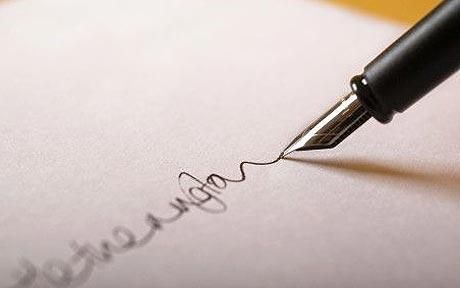
© telegraph.co.uk
My Catholic school third grade teacher was extremely tough on me. Her biggest gripe was my handwriting, which looks more like an EKG scan than penmanship. For years, I harbored not-so-fond memories of her, but now I know that her strictness about penmanship was actually helping my brain develop. Recently, scientists have shown that longhand writing benefits the brain.
Today, cursive writing is becoming a lost art as note taking with laptops becomes more and more prominent in classrooms. But what we are losing is much bigger than a few scratches on a page - we are losing a robust way of learning.
There has been much debate on the use of laptops for note taking in classrooms. The pro side sees laptops as an efficient way of collecting and storing information. The con side sees laptops as an opportunity for distractions and multitasking. What's missing is an understanding of how taking notes by longhand influences the brain.
Recent studies have shown that students taking notes with laptops performed worse on conceptual questions than the students taking notes by longhand. In short, they had the information on their computers, but did not have an understanding of that information in their brains.
So in this age of technology, I'm suggesting that students take notes with paper and pen. It's a crazy idea, but hear me out.
A Plea for PenmanshipWhen students take notes with their laptops, they tend to mindlessly transcribe the data word for word, like speech-to-text software. But taking notes verbatim is not the point.
What is lacking in their note-taking-by-laptop is the synthesis, the re-framing, and the understanding of the information. Students that transcribe with laptops have shallow connections to what's being presented to them. However,
those who are taking notes by hand are processing the information and representing it in a way that makes sense to them. They are learning.
Now, I'll be the first to say that longhand writing is so 19th century. But we need to answer a question: do we want students to have a deep or shallow connection to the information we're giving them? While we live in a world of short sound bytes where news is thrown at us unprocessed, this should not be the mode for schools. In the 21st century, the ability to connect knowledge in new ways is more important than the knowledge itself. So students with deeper connections to information can link it in new ways - they can create.
The Pen is MightierAll this begs the question of how we can incorporate longhand in a digital age. What about a daily notebook, written by hand?
A lost art in the world of science is the lab notebook. In it, scientists write down observations, impressions, and all the variables and outcomes of an experiment. If you are teaching STEM classes, might I suggest that you resurrect the lab notebook and have students personalize it? Give them assignments where they have to hand-draw pictures of what they see and what they predict. Let them figure out how to visually represent these things - without digital pictures, by the way.
The data says that taking images with a camera does not improve one's memory either, so these notebook entries must be written or drawn. Skill doesn't matter. What we are fostering are experiential links in a child's brain, and one of the best pathways is through their fingers.
If you are not teaching STEM classes, have students carry a personal notebook in which they write down observations and draw things by hand on whatever topic. We are trying to create more connections to information, and developing fine motor skills along the way.
If you have a classroom with lots of technology, try to integrate note taking. Often when I give my PowerPoint slides to students, I pass out a version that doesn't have all the information that students are seeing on the screen, which means that they need to fill it in by hand. And when I glance over their notes, I see how their work doesn't always look the same. This is great because my students are doing the most important thing we can teach them - they are learning how to teach themselves.
So let us not confuse efficiency with the real goal of teaching. Teaching is not a job of cramming as much as we can into a brain. It is about learning. And getting students to learn means that we must use every pathway to connect them with the information. Using laptops reinforces the Industrial Revolution ideal that every kid should get the information in the same way, and that it should come out the same way. But by occasionally replacing the laptop with a pen, learning happens, which is why we got into this business in the first place.
Comment: Read more about the benefits of longhand (handwriting):